I have always been a news junkie. I grew up with Huntley/Brinkley and Walter Cronkite. It was always a matter of debate in our family, and others as well, whether Cronkite was a Republican or a Democrat. The consensus over the years swung back and forth. David Brinkley’s ever-present on screen smirk convinced me that he thought they were all ridiculous. Chet Huntley was perhaps the most inscrutable of all.
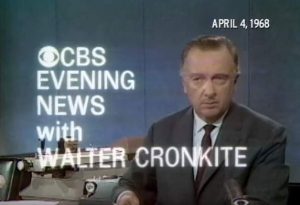
They gave us the news, they studiously avoided the appearance of bias. We’d look for the slightest of smiles or a single raised eyebrow, to give us a clue as to where the anchormen aligned themselves politically. To me, it was almost an impossible task. And that’s what I liked about them, and that’s why I trusted them.
But it’s fair to note that even then, the TV newscasts were at times accused of bias. Lyndon Johnson, a Democrat, thought the news was slanted against his administration. Later, the Republican Nixon administration made the same allegation. In every instance, the networks gave their accusers the opportunity to state their case, often without rebuttal or comment.
With a few notable exceptions, I cannot bear to watch the news today. No one even quibbles with the inescapable reality that the news is biased these days. It’s a given.
But even worse, the news, regardless of the platform, rarely gives me enough hard information to make me feel like I understand the issue being discussed. It’s shallow— the depth of the reporting is usually a mile wide and an inch deep. I long for an acknowledgement of nuance– an appreciation via its reporting, that no story is ever as black and white as the media insists on depicting it. I want to hear about those complications, those moral dilemmas. The gray zones. But it never happens. The reporters look for villains and victims. Nothing else.
In the last two decades, editors and publishers and their corporate masters have fired all the seasoned reporters, or “retired” them, for no other reason than to increase their profit margins. The vast majority of “journalists” today are fresh out of college, with virtually zero life experience. Most of the time, they’re clueless and committed to an agenda.
I try to watch the mainstream media interviews with our national leaders. I wait for the painfully obvious and critically necessary followup questions, when the initial answer only weaves and dodges and dissembles. (I yell at the screen, “Ask the damn question!”) They rarely come. With single-minded determination, the national media has helped to “dumb down” entire generations of Americans. There are few options. If I want to find the “rest of the story,” where do I go?

All news today, even supposedly hard news stories, begins with a preconception. Then its reporters and editors devote the rest of the story or segment trying to rationalize and justify their preordained conclusion. They only report the information that supports their bias.
The media has its allies and enemies. They publicize any misdeed if it’s committed by a person who that particular media source loathes, and ignores similar misdeeds if they’re committed by its allies. And I use the words allies and enemies without any fear that I might be misrepresenting one media performer or another. There’s not even the facade of impartiality now. It is a disgrace.
But I’m still a news junkie. What do I do? Where do I go? Where can I get real news and real information? One day, by sheer accident I found my answer. To find understanding and perspective of events occurring in our country in 2021, I simply needed to tune to Walter Cronkite. Again.
** ** **
First, it’s important to understand, “there is nothing new under the sun.” The same issues, the same crises and catastrophes that befall us now were happening decades ago, and in many cases since the beginning of human history. But as violent, or disease-ridden, or racist, or insensitive, or genocidal as the world might seem to us now, we’ve been there before and it’s interesting to see how differently those events were reported and how the public responded to them.

Recently I was seeking comfort and escape from the Dismal Reality known as 2021 (or 2020, Part 2) via my old cyber pal, YouTube. Whatever else I might loathe about the internet and the world wide web and social media, I still acknowledge that if used properly and intelligently, there is much to praise in this digital information age. To me, YouTube is like a vast unlimited Time Travel machine.
One evening, while looking for old Tonight Shows with Johnny Carson, I found a 1968 installment of the CBS Evening News with Walter Cronkite. It was a complete, unedited broadcast of the day’s news and even included the commercials. To my surprise, I realized that there are literally hundreds, perhaps thousands of other newscasts, from CBS, NBC and ABC. The Big Three of yesteryear.
And so, for the last month or so, I have immersed myself in the past, watching the news the way I remember and prefer it. Along the way, I’ve learned a great deal about our country and the world, its leaders and its people. Not only has it reminded and educated me about our recent history, it has given me special insight into a future that had not yet been written when these stories were first broadcast.
Here are some “the way it is, the way it was” examples…
NATURAL DISASTERS
In 2021, there is nothing that occurs in the natural world that isn’t caused by climate change. If we have a lot of hurricanes in a season, that’s the consequence of climate change. But if we have a slow hurricane season, that’s also a result of climate change. If it floods, it’s climate change…if we have a drought…yep…climate change. Wildfires? You guessed it.
In fact, it becomes clear to me that many younger citizens believe the extreme weather events that have struck the country and the planet over the last few years are unprecedented. You would think that America never endured a flood or a fire or a drought or strong wind before 2007.
And yet who recalls that one of the most destructive wildfires in California history occurred a half century ago? Over 400 homes in the Malibu area of Los Angeles were destroyed in the blaze. But of course, in the ensuing years, the homes were rebuilt, in even greater numbers, and the next wildfire is sure to cause much greater damage, simply because there is more human infrastructure to burn. (The following videos are set to play at the relevant stories)
In 1969, Hurricane Camille struck the Gulf Coast of Louisiana and Mississippi. To this day, it’s rated the second most intense tropical storm to ever strike the coast of the United States. The Category 5 hurricane had peak sustained winds of 175 mph and created storm surges as high as 24 feet. At least 259 people lost their lives and property damage was in the billions of dollars.
In 1993, Tom Brokaw and NBC reported on the massive flooding in the Mississippi River valley. It was the result of the wettest winter and spring in 121 years. Can you imagine such an extreme weather event, almost 30 years ago?
Just a week later, the floods were still wreaking havoc in the Midwest, while further east, a deadly heat wave was pushing electrical grids to the limit and dozens had died as a result of heat stroke and dehydration.
In all of these stories, the emphasis was always—how can we help? What can be done to ease the suffering? And there was always the expressed reality that Nature always has the last laugh. No one thought to cast blame.
POLITICS
Two years after Watergate and the excesses of the Nixon administration, a different kind of presidential candidate emerged. Jimmy Carter had been a one-term governor of Georgia when he announced his intention to run for the presidency in 1976. He was practically ignored by the media and his fellow candidates, and given little chance of success. But as the presidential primary season moved forward in the Spring, Carter emerged as the front-runner and by summer, Jimmy Carter was the presumptive nominee of the Democratic Party.
Few Americans knew much of his history. Carter was born and raised in Georgia. He had served in the Navy and he was a peanut farmer. Americans wanted to know more. On May 31 and June 1, 1976, NBC ran two long profiles on the nightly news, to help its viewers fill those gaps in their knowledge of Jimmy Carter.
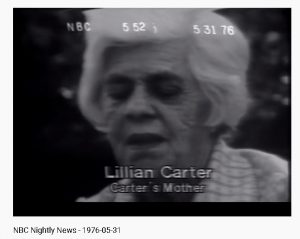
The profiles clearly revealed a decent and honorable man, devoted to democratic principles and to restoring dignity to the office of the presidency. Carter was also deeply committed to civil rights, and abhorred the racist stereotypes of previous Southern leaders. He said he wanted to help “restore respectability to the South.”
But Carter was candid about his past. He acknowledged that his family, more than a century ago, had been slave owners. It was nothing that he was proud of; it was simply a fact of history. One particular anecdote revealed his loyalty to the place of his birth. While a Naval cadet, his superiors had tried to force young Carter to sing the old northern war tune, “Marching through Georgia.” The song is a reference to General William Tecumseh Sherman’s infamous “March to the Sea” in late 1864. Sherman’s Union Army cut a swath across Georgia to Savannah and the coast, burning and destroying everything in its past. It ultimately crushed the Confederacy. A century later, it was still dangerous to mention Sherman’s name in front of a Southerner.
Carter, the young naval officer, refused to join in singing “Marching Through Georgia,” and was punished and ridiculed by his classmates. He said he wouldn’t turn his back on his “Southern heritage.”
These facts were offered by NBC without opinion and without consequence, because no one believed that Jimmy Carter was a racist. What his ancestors did 125 years ago were of no consequence. His record as a civil rights champion was not marred or doubted in any way, because he refused to join the chorus when he was 18 years old.
Can you imagine what would happen to Jimmy Carter now? In 2021? We live in a society where the statues of once honored Americans are ripped from their moorings because of perceived misdeeds committed centuries ago, in a completely different world, in a society we cannot even imagine.
We condemn the hearts and souls of history who never had the gift of residing in a future they never lived to see. Or learn from. A future we once called enlightened— where we look at our past and ourselves and each other with compassion and forgiveness.
Jimmy Carter would have been crushed in this day and age.
PROTESTS ( PEACEFUL & VIOLENT)
Our country endured one of the most violent years in our recent history in 2020. Cities were torched and looted by protesters. Hundreds of businesses were burned to the ground. Often the protesters’ violent actions were self-defeating. Leaders of the Black Lives Matter movement insisted that looting was a justified form of protest… that they deserved the loot for past injustices. I doubt the many small business owners who lost everything would agree.
Then, this winter, the Capitol of the United States was stormed and vandalized. Capitol protesters justified their behavior as well, insisting a national election had been stolen, though I have never seen any empirical evidence to support the claims. Self-righteousness rules.
But we have been here before. Many times.

On April 5, 1968, the day after the assassination of the Reverend Martin Luther King Jr, CBS reported on the aftermath of his killing. They described how the terrible event “sent a shockwave of violence” across the country.” And “Army troops moved into the capitol to protect strategic locations from the violence sweeping across the city.”
A CBS reporter on the scene narrated, “A stiff breeze fanned the flames of a half dozen fires set by looters along Seventh Street… they roamed back and forth, unhindered by the police, cheering as another plate glass window caved in, laughing at each other as they emerged with armloads of loot. There was little talk of Martin Luther King, just an occasional bitter remark, usually made by someone not involved in the looting, about the ‘white so-and-so’ who shot Reverend King… As the afternoon wore on, they stripped just about every store along an eight block stretch of the street.”
Network coverage of Reverend King’s assassination honored the man, examined the role of race and bigotry in his murder, but also respected the rule of law and reported unjustifiable violence when it occurred.
In 2020 we faced the threat of violence from extremist groups, Right and Left, all claiming the moral high ground to rationalize their acts of terror. We’ve been there before.
The Weather Underground (or Weathermen) was a prominent and deadly paramilitary force in the United States in the late 1960s and early ’70s. On March 6, 1970, a massive explosion ripped through a townhouse on 11th Street in Greenwich Village. Members of the organization were constructing bombs in the building’s basement when one of the explosive devices prematurely detonated; three Weathermen—Ted Gold, Diana Oughton and Terry Robbins—were killed in the blast.
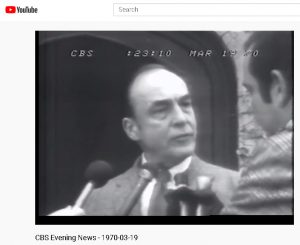
On October 19, CBS interviewed the father of one of the victims, Diane Oughton. She had come from a family of “power and wealth.” Her father ran the bank in a small town in Illinois. The family had started one of the first drug and alcohol treatment centers in the state. When Diane Oughton was identified as a victim in the explosion, her father consented to a short interview with CBS. He said he had been aware of her daughter’s concerns and had discussed her participation in the peace movement. “I gave her my ideas and she gave me hers…she had a feeling that the world needed changing, and so do I.”
The reporter, Ike Pappas asked her father how it could have come to this. He said simply, “She was almost carried away…it was like an intellectual hysteria…when we tear this world apart, what do we replace it with?”
A year later, on March 1, 1971, the Weathermen detonated a bomb inside the U.S. Capitol building. The explosion caused $300,000 in damage but there were no fatalities. Here’s how Howard K. Smith and ABC News reported it:
Protests and violence marked much of the late 1960s and 1970s. The networks reported all of it, whether the incidents were provoked by white groups or black groups, or by anti-war protesters or pro–war protesters. The news departments were there to report the facts, not to choose sides.
In 1969, police raids on the Chicago headquarters of the radical group, the Black Panthers, were reported by all the networks. Two of its members, including leader Fred Hampton died in the shootout. The Panthers insisted that the police had shot first and called Hampton’s death an “assassination.” Cook County attorney Ed Hanrahan called it a lie. Subsequent inquiries and Grand Jury investigations never fully resolved the controversy, but it was clear that excessive force had been used by the police in the raid. In 1970, a $47 million civil rights lawsuit was filed by the families of the two men killed in the raid. Twelve years later, the city settled with the families for $1.85 million.
In 1974, NBC reported on a shocking string of murders in the San Francisco area. Called “the Zebra killings,” John Chancellor explained, “white people killed by Blacks, for no apparent reason.”
NBC reporter Jack Perkins noted that 18 persons had been shot in the past five months, 12 of them had died, “all of this police say, done by the same men.” Eventually, at least 15 white people were murdered and eight wounded. Four African-American men, linked to a Black Muslim group called “The Death Angels,” were charged and convicted of first degree murder.
A criminology expert, Anthony Walsh wrote in a 2005 article that the “San Francisco–based Death Angels may have killed more people in the early- to mid-1970s than all the other serial killers operating during that period combined.”
When political rallies by 1968 presidential candidate Hubert Humphrey and his running mate Ed Muskie were interrupted by catcalls and chants, the news covered it. When the 1969 Harvard commencement ceremonies were disrupted, ABC News was there. And when presidential third party candidate George Wallace announced his running mate former General Curtis LeMay and the General advocated the use of nuclear weapons in Vietnam, Walter Cronkite felt there was no need to editorialize LeMay’s statement. The words stood on their own…
ATTACKS AGAINST THE MEDIA BY THE NIXON ADMINISTRATION
On November 13, 1969, Vice President Spiro Agnew delivered a speech in Des Moines, Iowa called “On the National Media.” In the address, Agnew attacked the three major news networks for their coverage of the Vietnam war and the Nixon Administration, charging that “A spirit of national masochism prevails, encouraged by an effete corps of impudent snobs who characterize themselves as intellectuals.” CBS devoted five minutes of its newscast to Agnew’s speech and the response to it by the public and other political leaders. CBS noted that a majority of the mail it had received since Agnew’s speech had supported the vice president.
Eighteen months later, Agnew again spoke out against the media, and specifically against CBS News, for the network’s special news broadcast called “The Selling of the Pentagon.” His March 19, 1971 comments were played at length by CBS and Cronkite did not respond to the criticism, other than to announce that the “Pentagon” program would be run again in prime time, the following week.
CLIMATE AND ENERGY STORIES
Hardly anyone these days doubts that the climate is changing, but few can confidently predict the rate at which it’s occurring. Are we possibly doomed in just nine more years, as John Kerry recently claimed, or are we looking at a long transformation that may take centuries to fully effect the planet? While there is an assumption by so many Americans in 2021 that environmental and climate issues are relatively new to the national conversation, the fact is, energy, environment, the use of fossil fuels, and even their effect on our climate have been nightly news topics for almost half a century.
Cronkite and CBS devoted entire segments of their news on a regular basis to the country’s pollution and energy crises. The first Earth Day, on April 22, 1970, was its lead story. Subsequent installments called, “CAN THE EARTH BE SAVED?” addressed various aspects of those problems.
Dire predictions were reported by respected scientists and academics and even from the halls of the United States Congress. Barry Commoner was a cellular biologist, one of America’s first “ecologists,” and considered to be one of the founders of the modern environmental movement. On that first Earth Day, Commoner addressed a standing room only hall of college students and offered this doomsday warning:
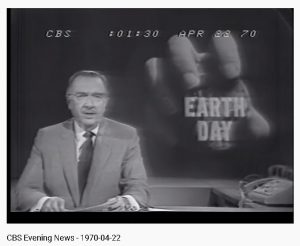
“This planet is threatened with destruction and we who live in it, with death. The heavens reek. The waters below are foul. Children die in infancy. And we and the world, which is our home, live on the brink of nuclear annihilation. We are in a crisis of survival.”
It was the opening of a CBS News program called:
“CBS NEWS SPECIAL. EARTH DAY: A QUESTION OF SURVIVAL”
It was hosted by Walter Cronkite, who in the first 90 seconds of the program rattled off a long list of great environmental challenges and stated the solution in three words: “Act or die.”
The best selling author of “The Population Bomb,” Paul Erhlich, was just as gloomy.
A half century later, many of those doomsday prophecies have failed to materialize. And thanks to the efforts of the Environmental Protection Agency (EPA) and the Clean Air and Clean Water Acts of the early 1970s, many of the toxic pollutants that marred America’s skies have been dramatically reduced. According to statistics from EPA, pollutants like carbon monoxide, lead, sulphur dioxide, and nitrogen dioxide have declined, by an aggregate reduction of 70% since 1970. The air is considerably cleaner now.
The challenge of Climate Change has little to do with these kinds of pollutants. The threat comes from the increase in Carbon Dioxide, which in fact, isn’t even considered a pollutant. But its increased concentration in our atmosphere is the concern that has preoccupied the world for the last decade. It’s hardly a new subject. The NASA climate scientist James Hansen is often noted for raising the issue of Global Warming in 1988.
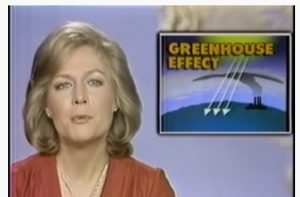
But one day, as I watched random newscasts from YouTube, I caught a short clip from an October 21, 1983 NBC News Digest by Jessica Savitch. It was just a 30 second blurb, but she referenced studies by the National Academy of Sciences and the Environmental Protection Agency. Both had addressed the issue of rising CO2 concentrations in the atmosphere and the catastrophic consequences they might have, decades into the future.
So I searched for more information and found a New York Times article that provided the depth and details that the NBC segment had missed. It was titled “Haste of Global Warming Trend Opposed,” and was stunning for several reasons. Keep in mind, this was written 37 years ago.
Here are long excerpts from the article:
A report issued today by the National Academy of Sciences says that the coming warming of the earth caused by a buildup of carbon dioxide in the atmosphere is ”cause for concern” but that there is sufficient time to prepare for its impact.
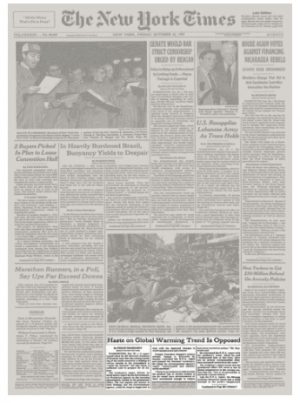
The academy’s report follows by three days a report by the Environmental Protection Agency on the warming phenomenon, known as the greenhouse effect.
The academy’s report warns that the greenhouse effect will cause a rise in global temperature in the coming century that has ”few or no precedents in the earth’s recent history.”
Like the E.P.A. report, the 496-page academy document warns that a rapid increase in the earth’s temperature and climate now seems inevitable and that its effects will begin to be felt by the turn of the century.
”Viewed in terms of energy, global pollution and worldwide environmental damage, the ‘CO2 problem’ appears intractable,” the report said.
Like the E.P.A., the academy also warned that the greenhouse effect was not likely to be prevented by reducing the use of coal and oil, the major sources of the carbon dioxide in the atmosphere.
Like the environmental agency, however, the academy found that since there is no politically or economically realistic way of heading off the greenhouse effect, strategies must be prepared to adapt to ”a high temperature world.” The E.P.A. report said even a total ban on coal would only delay the process for a few years.
‘‘We may get in trouble in ways we have barely imagined, like release of methane from marine sediments,” as rising temperatures cause new effects, the report warned.
On the other hand, it said, carbon dioxide by itself should have a beneficial effect on agriculture by improving the efficiency of photosynthesis, the process by which plants create carbohydrates and hydrogen to nourish themselves.
It also said the benefits and damage stemming from climate change would fall ”unequally on the world’s people and nations” and could therefore be a new, divisive factor in world affairs
‘‘The foreseeable consequences of climate change are no cause for alarm on a global scale but could prove to be exceedingly bad news for particular parts of the world,” the report concluded. ”Generally, the more well-to-do countries can take in stride what may prove to be a reduction by a few percent in living standards that will likely be greater per capita by more than 100 percent over today’s.”
In the United States, the effect may be felt on agriculture starting around the year 2000, the report said. With warming of about 1 degree centigrade by then, the growing season in the northern part of the country would be about 10 days longer. In the southerly farm belt, where most of the country’s wheat, corn and soybeans are grown, drier conditions could decrease crop yields between 5 and 10 percent.
As recently as 2007, a quarter century after these reports were released, much of the news and sentiment on global warming/climate change still followed similar lines of thinking. The Zephyr even featured a cover story called, “The Brighter Side of Global Warming,” albeit a tad tongue in cheek, but we quoted these very serious sources regarding ways to deal with the changing climate:
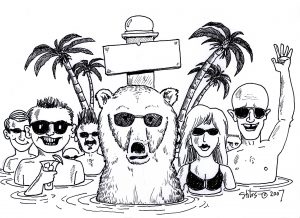
NEWSWEEK magazine observed recently that, “with further warming seemingly inevitable, the farsighted are already thinking beyond combating climate change. By government fiat or market force, humans will adapt, and that will bring opportunities as well as challenges.”
It notes that, with rising temperatures, “Russia, long a half-frozen terra incognita, will find its interior frontiers thrown wide open as the Siberian tundra turns to fertile prairie.” Of course, the lower latitudes of the planet will be scorched, “but America and other rich nations will be left relatively unscathed, because they are removed from equatorial regions that will be hardest hit, and wealthy enough to adapt.”
According to NEWSWEEK, even parts of last year’s otherwise chilling report on global warming shined some happy light on the issue. British economist Nicholas Stern reported, “In higher latitude regions, such as Canada, Russia and Scandinavia, climate change may lead to net benefits through higher agricultural yields, lower winter mortality, lower heating costs and a possible boost in tourism.”
And according to Alaska Business Magazine, “…increasingly, Alaska may find potential trade and economic benefits from global climate change. According to Mead Treadwell of the Northern Forum, sea routes across the top of Russia will soon become practical alternatives to shipping freight from the Pacific Rim to Europe…In addition, receding sea ice is slowly showing hints of a long-sought-for Northwest Passage, through the archipelago of Canada’s far north. Alaska stands at the crossroad of these new trade routes.” Treadwell cautiously added, “However before cruise ships or freighters ply these routes regularly, strong political obstacles must be overcome.“
The current global response to climate change–that our only hope to save the planet is to stop the increase in CO2 instead of accepting and dealing with a warmer world–is a recent phenomenon. It’s just that most of us can’t remember further back in time than five years. And so our current climate angst may feel like it’s had us by the throats forever, but the facts don’t bear it out.
One thing is certain. While I have no deep affection for the oil companies that drill the wells and find the oil and refine it into gasoline so I can drive my car, I have a difficult time blaming them for all our woes. Recent lawsuits have tried to suggest that Big Oil knew about all these Climate risks and kept feeding us oil anyway. And that as a result, they should be punished. The truth is, we ALL knew it. We were provided the information, and we weighed those facts against the lifestyle we have chosen to lead. Five administrations, both Democratic and Republican, heard the same news. Exxon didn’t put a gun to my head every time I filled my tank. We all knew exactly what we were doing.
Whether it’s “too late” to save us at this late date, or whether we really are in End Times as many believe, Time will tell us soon enough.
One Glimmer of Hope
If there is one glimmer of hope, and more proof that the more things change, the more they stay the same, I take some comfort from this NBC report from October 15, 1973… Listen to the stories of Charles Dixon and Calvin Parker of Pascagoula…
The UFOs bearing aliens were here in 1973 and from what I can see, they are everywhere now. Please… somebody. “Beam me up.”
Jim Stiles is Founding Publisher and Senior Editor of the Canyon Country Zephyr.
To comment, scroll to the bottom of the page.
Zephyr Policy: REAL NAMES ONLY on Comments!
Don’t forget the Zephyr ads! All links are hot!
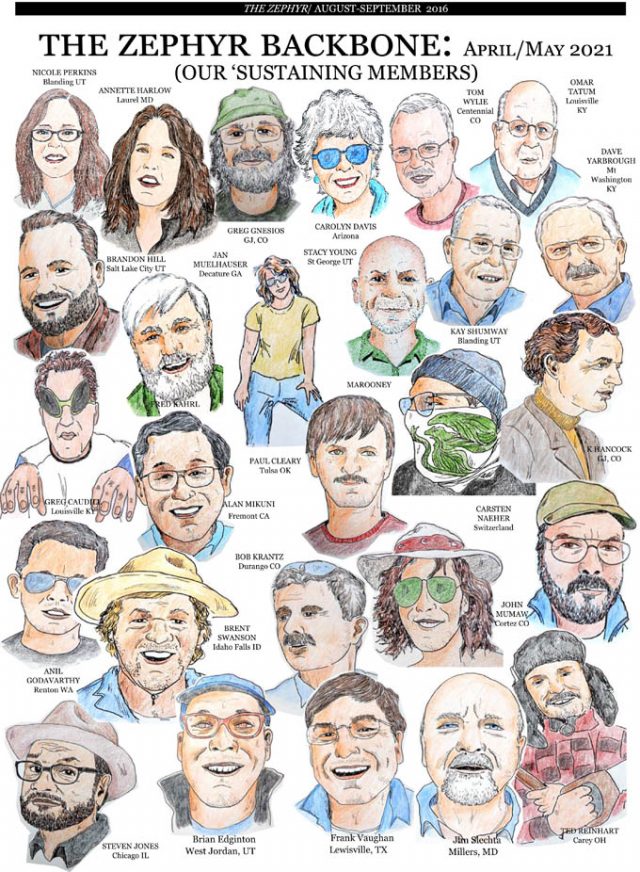





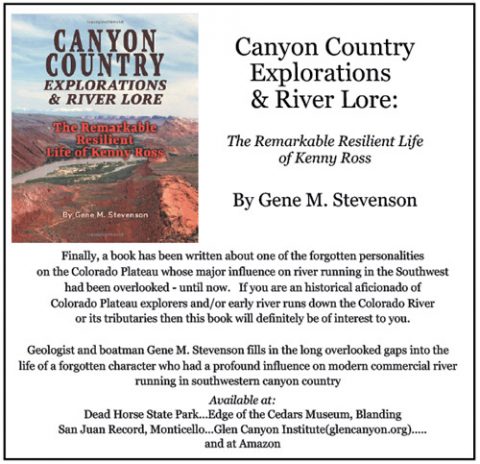


I grew up with Cronkite, Huntley/Brinkley, Sevareid, et al, and i sorely miss them. By comparison most of today’s “journalists” seem like carnival barkers.
I remember watching Cronkite, et al, in the ’60s, to see if one of mom’s little brothers in ‘Nam would show up in a film clip. I also remember there wasn’t much diversity in presenters, it was a white man’s world. In ’80 Turner changed things with CNN, and in the ’90s Ailes/Murdoch got in the game. They made news “entertainment” and competition for ratings/ad$ ramped up. Corporations bought networks (& politicians) to sell their agenda, not facts. The alphabet and cable news are meh, though I do find MSNBC to have some credible, albeit opiniony, reporting. Lots of talented and ethical journalists out there digging deep with a pointy stick, working solo or small venue, but they may not trade in soundbites. You have to dig around to find them and be prepared for a long read.
.
Google Earth Timelapse shows what climate change is doing, as well as deforestation, urban sprawl and other modern wonders: sample here – https://www.youtube.com/watch?v=NHf-xSvpF-Y Cheers